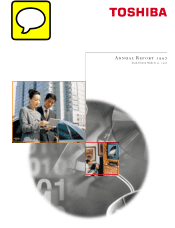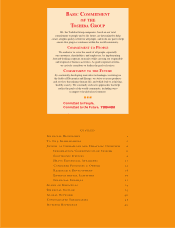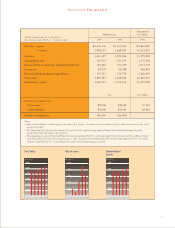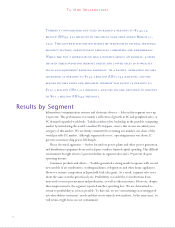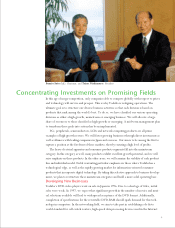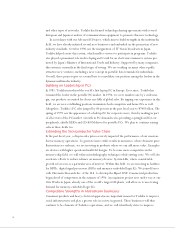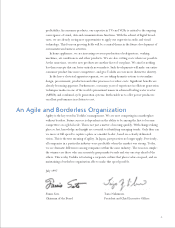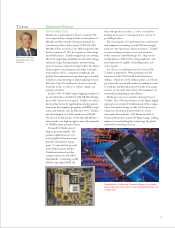Toshiba 1997 Annual Report Download - page 9
Download and view the complete annual report
Please find page 9 of the 1997 Toshiba annual report below. You can navigate through the pages in the report by either clicking on the pages listed below, or by using the keyword search tool below to find specific information within the annual report.
7.
© NASDA
Toshiba was awarded con-
tracts for the solar panels
and a large antenna for the
ETS-VIII engineering test
satellite, which is scheduled
to go into orbit in 2002.
Toshiba is aggressively promoting its Cell Switch
Router as the de-facto world standard. An alliance
with Cisco Systems adds impetus to this drive.
Sales of mobile commu-
nications equipment were
up sharply, backed by
explosive growth in
cellular and PHS phone
demand in Japan. One
highlight of the year was
Toshiba’s introduction of
the world’s smallest and
lightest PHS phone—
volume is only 68cc and
weight is a mere 81 grams.
Toshiba’s satellite business continues to perform
well. The company was supplier for the attitude
control system, solar panels and interferometric
monitor for greenhouse gasses on the ADEOS earth
observation satellite, which went into orbit in August
1996. The sensor is one of the most sophisticated
ever made, and is capable of detecting
from space atmospheric gasses that
can cause global warming. Toshiba has
received orders from the National
Space Development Agency of Japan
for key components of two more
satellites: the ALOS land observation
satellite and the ETS-VIII engineering
test satellite.
Labor Saving Equipment
Sales fell as orders were down from government
agencies, the financial services sector and transporta-
tion companies. One notable achievement was the
receipt of an order for letter sorting machines in
preparation for the February 1998 adoption in Japan
of seven-digit postal codes.
Medical Equipment
Toshiba was able to achieve higher sales in this sector
despite intensifying competition. This accomplish-
ment was mainly due to the introduction of pace-
setting new products. One of the most successful was
a helical-scan X-ray computed tomography
system with the world’s highest imaging
quality and continuous, real-time imaging.
A focus on growing markets in Asia,
Central and South America, and the Middle
East was another reason for the higher
sales. Toshiba maintains the number-one
position in Japan’s diagnostic imaging
equipment market. In 1997, Toshiba was
first in the world to pass the 100,000 mark
in cumulative production of electronic-scan
ultrasound equipment, a product the com-
pany began making in 1976.
Information & Communication and
Control Systems
As the forces of digital technology sweep through
information, communications and visual products,
Toshiba is stepping up its capabilities in system
integration. At the same time, the company is
placing more emphasis on the development of
servers, routers and other networking equipment.
In the field of servers, Toshiba introduced its GS
series of global network servers in October 1996.
These servers are reliable, easy to operate and have
the flexibility to function in a wide range of systems.
In addition, Toshiba introduced a Cell Switch
Router (CSR) that operates at a speed ten times
faster than conventional units. In November 1996,
Toshiba formed an alliance with Cisco Systems, Inc.
of the U.S. regarding the creation of standards for
multi-layer switching technology, a next-generation
high-speed Internet transmission technique.
Toshiba’s Opart MRI unit
requires no refilling of the
helium used to cool the
superconductive magnets.
This reduces maintenance
costs and makes the unit
less restrictive for patients.
To promote the develop-
ment of electronic com-
merce, Toshiba is playing a
central role in creation of an
IC card for Internet transac-
tions as well as purchases at
stores, which is now under-
going tests.
Toshiba is also targeting the SOHO router market,
which is showing signs of significant growth. In July
1996, Toshiba’s AR-600 made its debut in Japan.
This was followed in May 1997 with the TR-600 in
North America. Sales of both models were brisk.
To capitalize on opportunities in electronic
commerce, Toshiba has joined forces with Visa
International to establish in February 1996 a consor-
tium called Smart Commerce Japan. This organiza-
tion aims to create a global platform for electronic
commerce, and Toshiba is working on developing
and supplying the technology necessary for the IC
cards and various other elements of this system.
Toshiba entered the U.S. home PC market in 1996 with the
Infinia, which can also function as a TV, telephone and audio
component.

